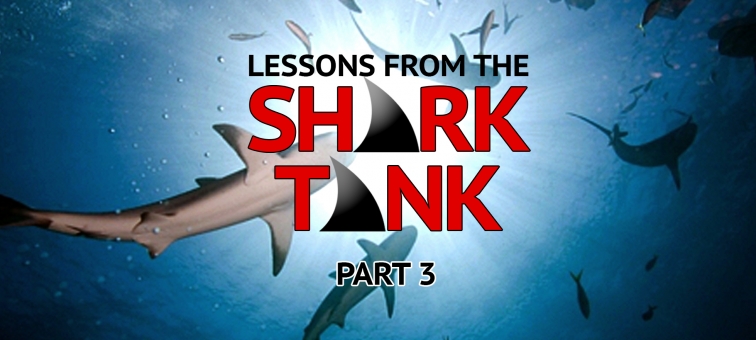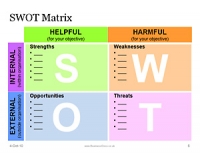
Lessons From the Shark Tank #3

Should You Swim with the Sharks?
I must admit I don’t watch a lot of television but I did enjoy the latest Australian season of Shark Tank where contestants (with an existing business or idea) seek funding from a panel of wealthy entrepreneurs (the sharks) in exchange for a percentage of their business. The funding is designed to help them grow their businesses or take their idea to market. While it’s another form of reality TV the show does provide business owners and budding entrepreneurs with some valuable business lessons.
The show has been running in the US for a number of years but is relatively new in Australia and the local ‘sharks’ in the tank are five incredibly successful entrepreneurs who collectively are reported to be worth close to $1 Billion. The shark panel is comprised of:
- Janine Allis (owner of Boost Juice and Salsa’s Fresh Mex Grill)
- Steve Baxter (internet pioneer and one of Australia’s most successful tech entrepreneurs)
- Andrew Banks (Talent2 Recruitment)
- John McGrath (McGrath Real Estate Agents)
- Naomi Simson (Red Balloon)
The contestants pitch their business concept to these self-made multi-millionaires who then grill them and then decide if they want to make an offer to take some equity in the business and mentor these entrepreneurs. It’s entertaining and like any television show, it’s heavily edited and I suspect several hours of footage is cut down to about 15 minutes per contestant.
It may well be a television show but it provides business owners and particularly people in the start- up phase of their business with some incredibly valuable lessons. In a series of blogs I’m going to address some of these important lessons and in this edition I’m going to look at whether you should swim with the sharks.
In Australia there are loads of aspiring entrepreneurs who have some innovative and brilliant ideas. Unfortunately, ideas without funding, marketing or a business plan rarely amount to much. Most small businesses stay small for a reason and some brilliant ideas and products never reach their full profit potential. At this point let’s define the term ‘small business’ and if we use the $20k instant asset write-off concession announced in the May 2015 budget, it was restricted to ‘small businesses’ with turnover of less than $2 million. The cold facts are, ninety-nine percent of businesses in this country have a turnover of less than one million dollars.
So how do you bridge the gap and turn your small business into a big business?
 Firstly, big business rarely happens by accident. The contestants on ‘Shark Tank’ are often guilty of presenting unrealistic and excessive business valuations but they do have a big vision. Of course a vision or idea without a plan amounts to nothing and I discussed the importance of planning in part one of this series. It includes what we call a SWOT analysis to identify your business strengths, weaknesses, opportunities and threats. New entrepreneurs often can’t see the weaknesses in their business model because they are totally focused on the product or service they are creating. On the other hand, a shark feeds on these weaknesses so if you don’t have a distribution network, a business plan and a clear marketing plan you could get eaten alive in the tank. As I explained in part 2 of this series, you also need to know your numbers.
Firstly, big business rarely happens by accident. The contestants on ‘Shark Tank’ are often guilty of presenting unrealistic and excessive business valuations but they do have a big vision. Of course a vision or idea without a plan amounts to nothing and I discussed the importance of planning in part one of this series. It includes what we call a SWOT analysis to identify your business strengths, weaknesses, opportunities and threats. New entrepreneurs often can’t see the weaknesses in their business model because they are totally focused on the product or service they are creating. On the other hand, a shark feeds on these weaknesses so if you don’t have a distribution network, a business plan and a clear marketing plan you could get eaten alive in the tank. As I explained in part 2 of this series, you also need to know your numbers.
The primary reason entrepreneurs enter the tank on this program is to attract a shark but why would you take on a ‘shark’ in your business?
Firstly, they have a track record of turning small business into big business. They have established networks and distribution channels with like-minded entrepreneurs that could fast track your success. Some of their connections could open doors that would have taken you a lifetime to open. The right shark, investor or joint venture partner could hook you up with distribution lines you never thought possible and on a scale beyond your wildest dreams. In business and in life, sometimes it’s who you know and a shark may have the potential to accelerate your success.
Their strengths could also complement your weaknesses. Too often ambitious entrepreneurs don’t recognise their weaknesses which stunts their business growth. Remember, you can buy the missing skills, outsource the task or look to form a joint venture or partnership to fill the skills gap. Either way,
you may have to give up some equity to get your business to the next level but it could prove a small price to pay. Before you enter the pressure cooker environment of a shark tank you need to be crystal clear on what your business is worth and how much equity you are prepared to release. It could be a case of some simple maths but owning 100% of a small business could amount to a lot less than owning 10% of a big business.
Now, if you’re a frustrated business owner and your revenue is flat lining or in decline I’m not espousing you rush off, find a partner and sell some equity in your business. Before you go down that route you need to do a SWOT analysis and identify the missing essential ingredients in your business. You may have a great product, a cutting edge website and a fantastic team but something is missing. You might have a blockage or barrier that you can’t overcome. For small and micro business owners the problem could be you!
In his best selling book, ‘The E Myth’ Michael Gerber points out that, “Most people work IN their business. The secret is NOT to work IN it, it’s to work ON it so that you don’t have to work IN it.” The fact is, most business owners struggle to find the time to work on their business because they’re caught up working in their business. The struggle to delegate and as a result they have simply created a job rather than a business that works independent of them. While you’ve probably heard it all before, a lot of business owners are great technicians and are really good at their craft. However, to turn a micro business into a big business you need a combination of talent, technical skills, perspiration, inspiration, business nous and marketing skills. A shark and their network and pool of resources could remove those barriers.
A word of warning. Swimming with sharks can be dangerous. Every business sale (or part thereof) is subject to a process and I’m almost certain that some TV deals end up ‘tanking’. These hardened sharks bring an exhaustive due diligence process with them and you also need to satisfy their legal departments. Ultimately this is a TV show designed to provide entertainment and when an excited contestant ‘hooks’ a shark they leave the tank with a verbal offer. There is a lot of water to go under the bridge before you get your hands on any cash. Also note that these people are ‘feeding’ on a dozen other entrepreneurs each season and you won’t get their undivided attention or immediate access to their pool of resources.
In summary, if you’re looking to start a business, raise capital or make an appearance on the TV show you need to do your homework. Know your numbers inside out and the starting point is prepare a business and marketing plan complete with cash flow projections. A SWOT analysis will help identify the skills you are missing. We can help you in all these areas and if you’re contemplating an appearance on the Shark Tank program, contact us today and we’ll make sure you’ve got the perfect pitch and the right bait to attract a shark.









